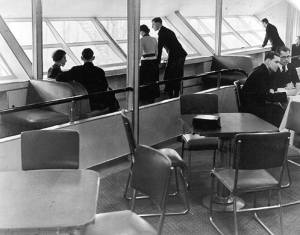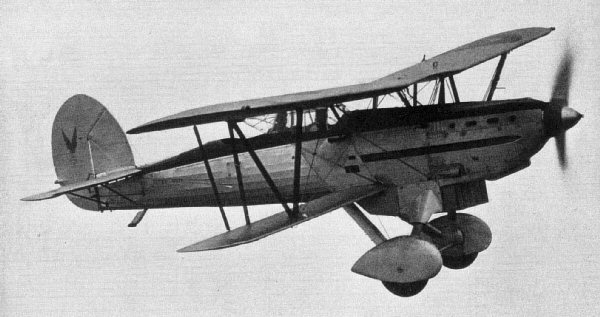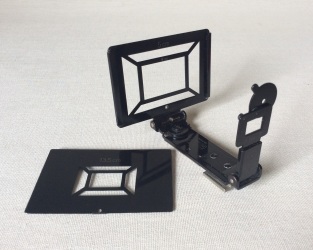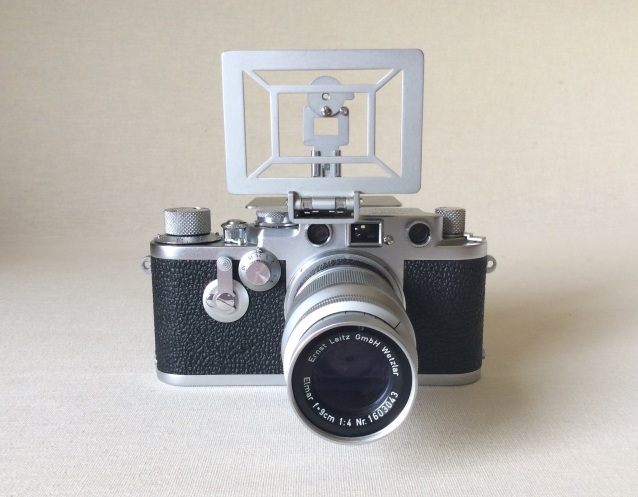A series of posts celebrating the early Leica camera accessory, ingenious and often beautiful small masterpieces of functional design. Ernst Leitz produced the first ‘system’ camera in 1930 (the Leica 1 Model C), and by 1933 the accessory catalogue ran to over 100 pages. These were so well designed that many were still in production over 20 years later. See the first post for the Leica story.
If you were planning to travel on an airship in the 1930s, go for a joy ride over the beach in a bi-plane, or spend the day at a race track, you would have packed a RASAL frame finder in your camera case rather than the usual VIDOM or Torpedo viewfinder (see previous post for details of these).
Main picture of the Hindenburg by the great Leica photographer Paul Wolff. You get a sense of the colossal size of this airship by the windows that the passengers are looking out of, which are the three groups of tiny black rectangles just above the linear bulge on the side of the hull!
Designed for aerial or sports photography it was a simple framing device for various focal lengths of lens which had the great advantage that you could see a subject before it came into the camera lens viewpoint. Ideal therefore for photographing from the air or fast moving racing cars or horses, especially as the other two viewfinders showed the image in reverse.
The early types from 1933 had marked frames for 3.5, 5, 7.3 and 9cm lenses (in Leitz telegraphic code* RASUK) and also had a detachable mask (RAMET) for 10.5 and 13.5 cm lenses**, both together coded RASAL (the separate mask usually got lost so complete RASALs are quite rare).
Originally finished in black enamel with ‘Wismut’ engraving (see the previous Leica post for an explanation of this process), by the mid-thirties they were also available in chrome finish for another 4/- (in the UK).
For precise alignment of the longer focal lengths it was necessary to swing down a small pinhole mask over the rear sight.
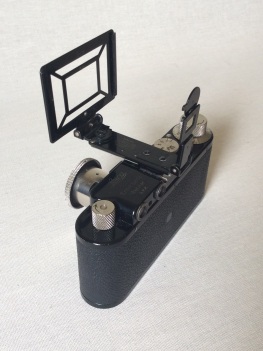 You could also adjust this sight up or down for parallax compensation. They do look terrific on the camera, especially the early black ones, rather like a modern underwater camera viewfinder.
You could also adjust this sight up or down for parallax compensation. They do look terrific on the camera, especially the early black ones, rather like a modern underwater camera viewfinder.
The post war version (ROSOL) introduced in 1951, only in matt chrome finish, had revised frames for 5 and 9 cm lenses with a hinged mask (for 8.5 and 13.5 cm, then later only 13.5 cm) so you could fold it out of the way, and not lose it. This is on a Leica IIIf vorlauf with 9cm Elmar lens.
The ROSOL would have been just the thing for capturing fast moving racing cars such as this Maserati 250F driven by Fangio in the early 50s.
*LEITZ TELEGRAPHIC CODES
Leica aficionados are familiar with the quirky, and sometimes unintentionally hilarious, codes that Ernst Leitz provided for everything that they sold, from cameras and binoculars to darkroom accessories and rolls of gummed paper. In fact this was quite common for manufacturers since the start of the telegraph. You generally paid by the word for a telegram so asking Leitz to send another 6 “Extra long arms for attaching the Leica to the upright of the Large Copying Device with nose for the auxiliary housing” would have cost a lot more than just asking for 6 more VEARMs. It also avoided any confusion between similar products. Generally made up of of five letters some of the codes were loosely based on German words for the item, such as the above example. One of the first lenses, the ‘Hektor’, was named after the lens designer’s*** dog, the code being HEKTORKUP (nine letters)! Some are amusing to English speakers such as NOOKY (close-up device for the Elmar lens), POOHY (red filter), or ACHOO (Leica III camera). The derivation of most, such as VOLIG, VOMIR, VOOAL, VOODZ, VOOWI (enlarging equipment parts), is a total mystery. Not foreseen by Leitz, for modern collectors these code words are a boon when searching on Ebay!
**LEICA LENS focal lengths
There was some confusion in the early days of the Leica when describing the focal lengths of the lenses. In all the catalogues they are shown in centimetres, ie Elmar 5cm. However, on the early lenses it is marked as f=50mm. Similarly with the early 30s Elmar telephoto, shown in the catalogue as 13,5cm focal length but marked on the lens as f=135mm. However, the same period Hektor lens focal length is shown in cm both on the camera and in the catalogue. After the mid thirties the lens markings in cm matched the catalogue. The metric comma was usually used pre-war, with the ‘dot’ being used from the 50s (ie 13,5cm/13.5cm)
***Professor Max Berek, Leitz head of optical design
Photo credits from top:
Hindenburg at Rhein-Main Airport 1936 (Archiv Dr. Paul Wolff & Alfred Tritschler)
(L) Hindenburg casting its shadow over the Brazilian coast 1936 (Archiv Dr. Paul Wolff & Alfred Tritschler)
Paul Wolff was the photographer who did the most to popularise the Leica and 35mm photography in the 20s and 30s with many books and articles. All his negatives were lost in WW2 but a gallery in Salzburg has many of his surviving prints and is apparently publishing a book on Wolff with an exhibition. Timing not known. The photographer and Leica enthusiast Thorsten Overgaard has an interesting piece about Wolff on his blog:
http://www.overgaard.dk/the-story-behind-that-picture-0122_gb-Dr-Paul_Wolff.html
(R) Hindenburg Observation Lounge from a fascinating website about the Hindenberg and other airships www.airships.net/hindenburg/interiors
1930s Fairey Fox bi-plane (Wikimedia Commons – no source)
Fangio and Maserati 250f (Wikimedia Commons – Author: 玛莎拉蒂 Source: 玛莎拉蒂中国)
Other Opinionated Designer posts on Leica:
Miniature Masterpieces – Leica VISOR, VIDOM, and VIOOH Viewfinders
Miniature Masterpieces – Leica APDOO, WINKO, WINTU, and AUFSU
Miniature Masterpiece – FIKUS Variable Lens Hood
The ‘bible’ for accessory aficionados is ‘Leica, An Illustrated History, Volume III – Accessories’ by James Lager (1998 ISBN 0-9636973-3-1)



